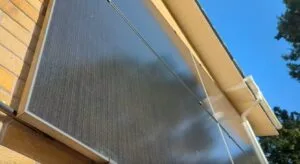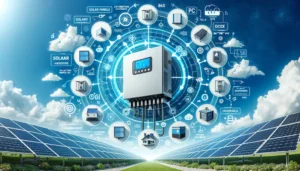Learn the essential tips for connecting solar panels in series or parallel. Get advice on optimal wiring for extending solar capacity and string wiring.

Understanding solar panel connections is crucial for both efficiency and safety. As solar panels become increasingly affordable, newcomers and seasoned users expanding their systems stand to gain optimal energy outputs through a deeper knowledge of how different wiring methods affect the characteristics of their solar string. Equipped with that knowledge, you can discover a path to expanding your system or making the most of your already planned expansion.
Solar Panel Connection Calculator
Use this calculator to see how varying the types of panels you connect and the strings affect the expected voltage and current of the system.
This may be overwhelming initially, but it will make much more sense when you read the article and understand the concepts of connecting panels.How are the strings connected?SeriesParallel
String 1
Panels Connection TypeSeriesParallelNumber of PanelsVoc (V)Isc (A)Remove StringAdd String
Learn how these numbers work, read the full article.
Connecting Solar Panels in Strings
Connecting multiple solar panels is essential for efficient electricity generation in domestic solar energy systems. Connected panels can cumulatively reach the higher voltage or current that many inverters need. Consider this: many inverters need at least 90V to start converting solar energy into usable AC power, but typically, panels go up to around 50V.
Wiring panels into strings creates a more streamlined system and ensures a consistent power supply, which is especially crucial when using hybrid inverters that power homes and charge batteries simultaneously. Moreover, using a single charge controller for a string of panels is more efficient than managing multiple controllers for individual panels. Let’s explore what options we have.
Wiring Solar Panels in Series

In series, you wire the negative end of one panel to the positive end of the next. When wiring in series, you sum up the voltage of each panel to produce the total voltage of the string. The current remains at the current of the least-performing panel. Hence, even partial shading can cause a significant drop in performance on strings wired in series. In other words, a single panel can bring down the current for the entire string when wiring in series.
Luckily, solar panels have built-in coping mechanisms such as bypass diodes and half-cells. Additionally, these effects can be mitigated by favourable wiring or installing Solar Power Optimisers .
| Example Output of a String Connected in Series | |||
|---|---|---|---|
| Panel 1 | Panel 2 | String | |
| Voltage | 40V | 40V | 80V |
| Current | 3A | 3A | 3A |
| Output power | 120W | 120W | 240W |
Wiring Solar Panels in Parallel

In parallel wiring, you wire all negative poles of all panels to the same line. Respectively, all positive poles to another line. Then, you connect each line to the respective connectors of the inverter. In a parallel connection, the voltage remains equal to the voltage of the lowest voltage panel. The current adds up from each panel.
| Example Output of a String Connected in Parallel | |||
|---|---|---|---|
| Panel 1 | Panel 2 | String | |
| Voltage | 40V | 40V | 40V |
| Current | 3A | 3A | 6A |
| Output power | 120W | 120W | 240W |
Can You Mix Different Spec Solar Panels?
Mixing different panels is possible, but it has to be used with caution because, when done wrong, it harms your system. It all boils down to the voltage and current of the panels you’re mixing and how you connect them.
Connecting Different Spec Solar Panels in Series

Mixing panels with different voltages but equal currents may work well when connecting them in series. When connected in series, the voltage of each panel is summed up to the voltage of the string, whereas the current remains equal to the panel with the lowest current connected in the series.
As you can see in the diagram above, we have two strings connected in series. In one of the strings, we have panels with different voltages, 40V and 35V, respectively and equal current 3A. This string’s voltage is the sum of the voltage of the panels 75V, and the current remains constant at 3A. At the same time, something interesting is happening in the other string. The other string consists of panels with different currents, 3A and 2A, respectively. The voltage increases again, making 80V, but the current remains at the lowest-current panel in the series, 2A.
| Mixing Solar Panels and Connecting in Series – Left String | |||
|---|---|---|---|
| Panel 1 | Panel 2 | String | |
| Panel voltage | 40V | 35V | 75V |
| Panel current | 3A | 3A | 3A |
| Panel power | 120W | 105W | 225W |
The left string can still realise its full potential here, and wiring in a series has no negative effect.
| Mixing Solar Panels and Connecting in Series – Right String | |||
|---|---|---|---|
| Panel 1 | Panel 2 | String | |
| Panel voltage | 40V | 40V | 80V |
| Panel current | 3A | 2A | 2A |
| Panel power | 120W | 80W | 160W |
This string is underperforming because the series connection is a suboptimal choice for panels with different currents.
Connecting Different Spec Solar Panels in Parallel

Mixing panels with different currents but equal voltages can work well when wiring them in parallel. When connected in parallel, the current of each panel is summed up to the total current of the string. On the other hand, the voltage remains equal to the lowest-voltage panel in the parallel string.
As you can see in the diagram above, we have two strings connected in parallel. In one of the strings, we have panels with different currents, 3A and 2A, respectively and equal voltages, 40V. This string’s current is the sum of the current of the panels, 5A, and the voltage remains constant at 40V. At the same time, something interesting happens again in the other string. The other string consists of panels with different voltages, 40V and 35V, respectively and equal current, 3A. The current adds up again, making 6A, but the voltage remains at the lowest voltage panel in the series, 35V.
| Mixing Solar Panels and Connecting in Parallel – Left string | |||
|---|---|---|---|
| Panel 1 | Panel 2 | String | |
| Panel voltage | 40V | 40V | 40V |
| Panel current | 3A | 2A | 5A |
| Panel power | 120W | 80W | 200W |
Connecting in parallel has no negative effect on the left string. This is because the voltage is constant, and the current adds up from each panel.
| Mixing Solar Panels and Connecting in Parallel – Right string | |||
|---|---|---|---|
| Panel 1 | Panel 2 | String | |
| Panel voltage | 40V | 35V | 35V |
| Panel current | 3A | 3A | 6A |
| Panel power | 120W | 105W | 210W |
The parallel connection is a suboptimal choice for this string of panels with different voltages. As we can see, the voltage of the string drops to the lowest voltage panel. Even though the currents add up, we still cannot realise the full potential of the panels.
Practical and Safety Advice
Remember, DC carries added risk, so keep managing that risk and mitigating it at any chance. Stay safe when wiring solar panels.
- Wiring solar panels in daylight is inherently more risky as the sunlight increases their voltage and current. Mistakes are exacerbated compared to lower light conditions.
- Inspect your MC4 connectors for cracks or damage. MC4s are a huge help when wiring solar panels, so keep them safe and avoid hitting or pressing them with heavy objects.
- Use a multimeter to check the correct polarities and the voltages you’re working with are at the expected values.
- Ensure the direction of the poles is as expected. Put the black multimeter terminal to the negative pole and the red terminal to the positive pole, and you should see a positive voltage in the measurement. If the voltage value is negative, your poles are opposite of what you expected.
- Work at an open circuit. This means that the ends of your string are not connected to anything yet, or if they are connected somewhere, then that thing is an isolator, and it is switched off. Only connect your string to the inverter and switch the inverter on when you are done wiring your solar panels.If you intend to modify a working string, switch off the isolator where the string terminates and then do the work.
- When wiring solar panels, ensure the cables are neatly tucked and tidied at the back side of the panel and the frame. Avoid cables or MC4 connectors dangling about and getting in contact with other surfaces such as roofs, the ground, walls, etc. This will keep your system safe in case of winds, snow or other extreme weather conditions. Most panels have holes in their frames, which come in handy for attaching cable ties or other cable management items. Leave the cable ties slightly loose. Your future self reaching under a panel to release a cable will thank you dearly for the 2 centimetres of space around the cable that lets you cut the cable tie without sweating.
Parallel vs. Series Wiring: Which One To Choose?
These options can work well in specific cases and underperform in others. The key to choosing is to find out what case you are dealing with. Let’s explore some practical scenarios and see how to solve them using parallel, series, or maybe both.
Add to the Existing String Using the Same Configuration When Possible
It is best to follow the way your string is connected already when the additional panels have the following similarities with your string:
- Same current ( if your panels are connected in series) or same voltage ( if your panels are connected in parallel ).
- Angle and facing the same direction.
If connecting in series, make sure that the additional panels will not take your string’s voltage over the maximum inverter voltage. Exceeding the inverter’s maximum voltage can damage the inverter.
Can The Solar Panels String Exceed the Inverter’s Current?
Exceeding the current is possible and sometimes practical. The MPPTs inside of the inverter draw only the current they can handle. An analogy of this is how your home appliances work with the power grid. There the voltage is kept within strict limits, i.e. in the UK, we have 216.2 volts to 253.0 ( 230 volts -6%, +10% ), but there is a large current that can be drawn if needed.
There is a drawback to exceeding the current, though. In case of a short circuit inside the MPPT, all available current will be drawn, which can cause burn damage.
Best for Adding More PV Capacity for Winter Months or Rainy Days Cover
Adding more panels exceeding the power of your inverter is a valid option. There is a limit to that, but it is above the inverter’s rated power. So, the inverter will cope with the extra power at peak times if you stay within the limit.
If space and voltage permit expansion, add panels to the existing string.
Alternatively, you may be looking to double the capacity of an existing string for rainy days specifically. In bad weather and overcast days, panels show a more uniform performance. Effectively, all your panels work with defused light. So, unsurprisingly, orientation and angle don’t have as pronounced effect on such days. However, if you want to add panels in parallel, you need to consider a few things. Let’s explore why.
Avoid Connecting in Parallel When High Mismatch Is Expected
In the paper Mismatch losses in a PV system due to shortened string by the University of Central Florida, Orlando, FL, United States, we can see power losses when parallel strings experience differences in voltage and current. The authors use shortened strings for their experiments. However, the conditions are similar to what parallel strings at significant differences in angle or direction may experience. We can see that the rate of efficiency losses increases with the increase of discrepancy.
Additionally, reverse currents ( one of the strings sending current through the other string ) may occur with large enough discrepancies. This can lead to heat generation in the panels and potential damage.
There is some good news, too: bypass diodes can help with mitigating these effects. The conclusion is that we should avoid stark differences in sunlight conditions between the strings when installing parallel arrays.
What about when the weather is sunny?
That’s where the tradeoff appears when your string’s new current exceeds the maximum current of the inverter. For example, your string’s maximum current is 20A but your inverter can only utilise 10A.
As a result, in optimal conditions, some of the string’s potential will remain underutilised.
Expanding With Panels at a Different Angle
The best option for this case is to connect another string to a dedicated MPPT. When this is not possible, you should look into parallel wiring.
Most likely, you don’t have extra space where your string stands. So, the additional panels have to go elsewhere. For example, you have panels on your roof, and you decide to add a few more on a conservatory roof, a lean-to, a lean-to, a garage, a shed . If you opt for wiring in series, one of your strings may drag down the other.
Aim at keeping the mismatch of conditions for the parallel string as little as possible. As mentioned above, stark differences in conditions may cause additional power losses. Tigo, a leading solar panels power optimiser producer, recommend keeping that mismatch within 25% .
Expanding With Panels at a Different Angle or Orientation With Optimisers
An alternative to parallel wiring can be to use Solar Power Optimisers. They can help optimise panels in sub-optimal conditions or bypass them to let the string operate at its full potential.

Adding a South-Facing String to an Existing East and West Split
Likely you have an inverter with two strings where one of the strings takes the east-facing, and the other takes the west-facing string. A south-facing string is significantly more performant year-round than east or west. Therefore, the best option is to free up one of your string input slots for the south-facing string. The east and west then go in parallel. This is a tradeoff where we may be sacrificing some peak power in the summer days but boosting productivity through the rest of the year.
Conclusion
Different wiring configurations impact home solar energy systems’ overall efficiency and safety. We have seen how to optimise our strings’ current and voltage by wiring in series or parallel. We have also seen the nuanced approach needed when dealing with varying voltages and currents. We discussed these in light of efficiency losses and potential damage from reverse currents, especially in parallel arrays. Stay safe, inspect your connectors and use your multimeter for polarity checks.
The key to successful solar panel wiring is thoroughly understanding your system’s requirements and adapting the wiring strategy accordingly. With the detailed knowledge from this article, you can make informed decisions on the optimal strategy for your system.



